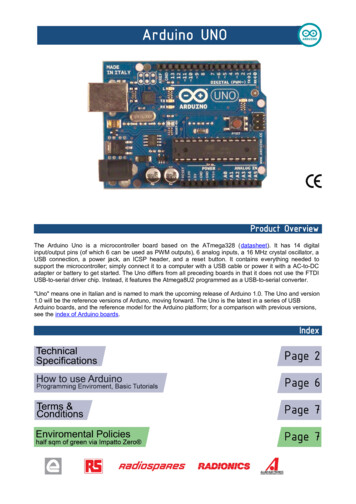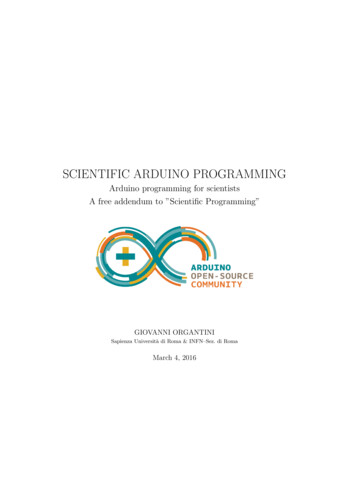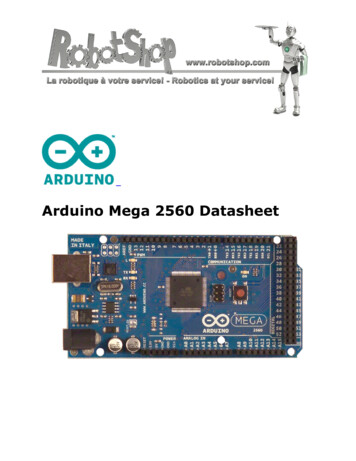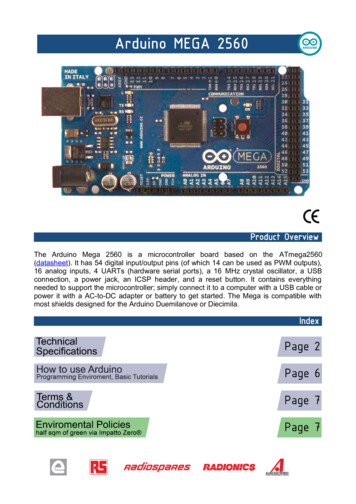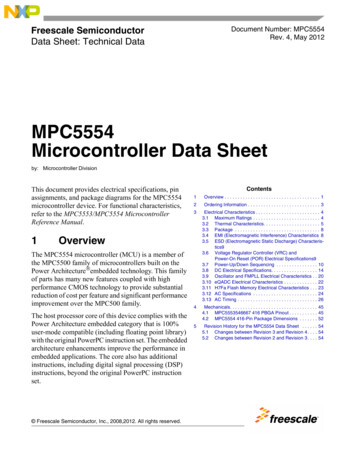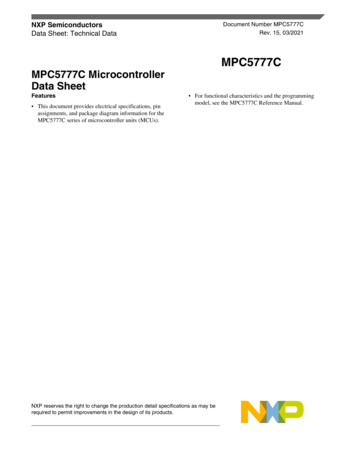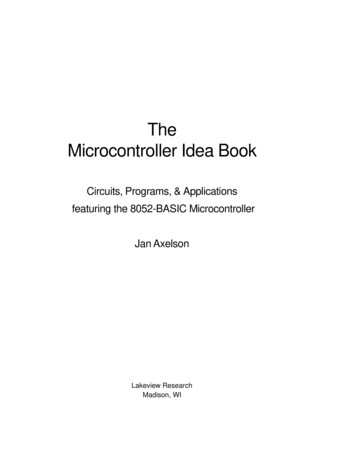
Transcription
TheMicrocontroller Idea BookCircuits, Programs, & Applicationsfeaturing the 8052-BASIC MicrocontrollerJan AxelsonLakeview ResearchMadison, WI
copyright 1994, 1997 by Jan AxelsonPublished by Lakeview Research14 13 12 11 10 9 8 7 6 5 4Lakeview Research5310 Chinook Ln.Madison, WI 53704USAPhone: 608-241-5824Fax: 608-241-5848Email: jaxelson@lvr.comWWW: http://www/lvr.comNo part of this book, except the programs and program listings, may be reproduced in anyform, or stored in a database or retrieval system, or transmitted or distributed in any form,by any means, electronic, mechanical photocopying, recording, or otherwise, without theprior written permission of Lakeview Research or the author, except as permitted by theCopyright Act of 1976. The programs and program listings, or any portion of these, may bestored and executed in a computer system and may be incorporated into computer programsdeveloped by the reader.TrademarksMacintosh is a registered trademark of Apple Computer. Procomm Plus and Datastorm areregistered trademarks of Datastorm Technologies, Inc. VT100 is a registered trademark ofDigital Equipment Corporation. IBM is a registered trademark of International BusinessMachines Corporation. MCS-BASIC-52 and Intel are registered trademarks of Intel Corporation. Microsoft, MS-DOS, GW-BASIC, and Microsoft Windows are registered trademarksof Microsoft Corporation. Philips is a registered trademark of Philips International BV.The author and publisher have used their best efforts in preparing this book and thematerials in it. The author built and tested the electronic circuits described, ran and testedthe computer programs presented, and reviewed all materials for completeness andaccuracy. The author and publisher make no warranty with regard to the circuitschematics, program listings, and other materials in this book. The author and publishertake no responsibility for any damages resulting from any use of the material in this book.ISBN 0-9650819-0-7
Table of ContentsChapter 1Microcontroller BasicsWhat’s a Microcontroller? 1A Little History 2New Tools 3Project Steps 41Chapter 2Inside the 8052-BASICPossibilities 11Limits 13What You Need 14The 8051 Family 16Elements of the 8052 and 8052-BASIC 1711Chapter 3Powering UpAbout the Circuit 23Circuit Construction 30Powering Up 35Basic Tests 38Simple Programs to Try 40Exiting Programs 4423Chapter 4Saving ProgramsNonvolatile Memory Options 47Adding NVRAM or EEPROM 50Using the Programming Commands 53Adding Bootup Options 5447iii
Erasing NV Memory 55Adding more NVRAM or EEPROM 56Adding EPROM 56EPROM-programming Circuits 57Power Supplies for Programming 61Storing Programs on Disk 63Chapter 5ProgrammingProgramming Basics 65BASIC-52 Bugs and Things to Watch Out For 69Finding Program Errors 70BASIC-52 Keywords by Function 72Quick Reference to BASIC-52 7465Chapter 6Inputs and OutputsThe Memory Map 87Uses for I/O Ports 89Adding Ports 89The 8255 Programmable Peripheral Interface 9887Chapter 7Switches and KeypadsSimple Switches 109Adding a Keypad 116109Chapter 8DisplaysUsing LEDs 1257-segment Displays 129Displaying Messages 138Inside the Display Controller 140Mounting Displays in an Enclosure 152125Chapter 9Using Sensors to Detect and MeasureSensor Basics 153Choosing Sensors 154On/off Sensors 155Analog Sensors 156Sensor Examples 163Level Translating 167Choosing a Converter 169153Chapter 10Clocks and CalendarsBASIC-52’s Real-time Clock 171A Watchdog Timekeeper 174171iv
Chapter 11Control CircuitsSwitching Power to a Load 185Controlling a Switch Matrix 187Op Amp with Programmable Gain 189Controlling a Stepper Motor 191Speed Control of a Continuous DC Motor 195185Chapter 12Wireless LinksInfrared Links 199Increasing the Distance 212Radio Links 216199Chapter 13Calling Assembly-language RoutinesAssembly-language Basics 218What You Need 218Loading a Routine 221File Formats for Assembly-language Routines 222Assembling a Program 224Uploading a Program 225Example: Creating a Sine Wave 227Avoiding Program Crashes 231Interrupts 232Adding Custom Commands and Instructions 233A General-purpose EPROM Programmer 237217Chapter 14Running BASIC-52 from External MemoryReasons 239Copying BASIC-52 240System Requirements 241Storing BASIC-52 Programs 243239Chapter 15Related ProductsEnhanced BASIC-52 245BASIC Compilers 246Programming Environments 247Pc Boards 248BASIC-52 Source Code 250245Appendix A SourcesBooks 251BBS’s 254Product Vendors 255251v
Appendix B Programs for Loading Files263Appendix C Number SystemsAbout Number Systems 271Kilobytes and Megabytes 273271vi
IntroductionIntroductionThis book is a hands-on guide to designing, building, and testing microcontroller-baseddevices. Microcontrollers, or single-chip computers, are ideal for projects that requirecomputer intelligence, but don’t need the overhead of a complete personal computer withdisk drives, keyboard, and full-screen display.Why the 8052-BASIC?This book focuses on the 8052-BASIC microcontroller, which is easy to use, full featured,and inexpensive to work with. The on-chip BASIC-52 programming language enables youto write, run, and test your programs quickly. With over 100 commands, instructions, andoperators, BASIC-52 is more capable than other microcontroller BASICs. And, as a memberof the 8051 microcontroller family, the 8052-BASIC has a standard, popular architecture.The ideas and applications presented here are not limited to the 8052-BASIC, however. Ifyour favorite chip is a different one, you can adapt the circuits and programs to it. Theschematics and program listings in this book include comments and explanations to helpyou apply the ideas, whether or not you are using the 8052-BASIC.vii
IntroductionWhat’s Inside?This is not just a textbook that presents information but glosses over the details of how toapply it. Inside, you’ll find practical information, including the following: Complete circuit schematics and parts lists—so you can easily build the circuitsyourself. Design theory—for example, why use this particular component? or how can I expandor modify the circuit shown? Example program listings—for easy testing and use of the circuits. Construction and debugging tips—to help you get the circuits up and running withoutproblems.The appendices include a complete list of sources to help you find the components andadditional information you need for your projects.Because microcontroller projects involve both circuit design and programming, I cover boththe hardware and software aspects. The book begins with an introduction to microcontrollers, and to the 8052-BASIC chip in particular. Next are basic circuits to get you startedprogramming and interfacing to the chip, along with the reasons behind the component anddesign choices, and construction details for prototyping. To the basic circuits, I show howto add switches, keypads, displays, and other input/output interfaces.A programming reference describes each of BASIC-52’s keywords, with specific tips fortrouble-free programming in BASIC-52.You’ll also find out how to add these to your system: Sensors, for detecting detect and measuring physical properties. Clock/calendar functions, for keeping track of seconds, minutes, hours, days, months,and years, and to trigger alarms at particular times. Control of AC power, switch matrices, stepper and continuous motors, and gain of anop amp. Programmable wireless links, for situations where stringing wires isn’t practical orconvenient.viii
IntroductionA chapter on assembly-language interfacing shows how to add assembly-language programsfor faster program execution, how to add your own commands the BASIC-52 programminglanguage, and how to use the 8052-BASIC as a development system for an all-assemblylanguage project.The final chapters cover other options for 8052-BASIC systems, including how to storeBASIC-52 in external memory rather than in the 8052’s internal ROM, and a review ofrelated products, including BASIC compilers, 8052-BASIC circuit boards, and developmentsoftware for more convenient and possibly cheaper project development.Your Feedback Is WelcomeThis book is the result of requests from readers of my articles in ComputerCraft magazineand its successor, The MicroComputer Journal. I’ve expanded the coverage of several topics,including programming of EPROMs and other devices, display options, sensors, andprogramming tips.Thanks to everyone who responded to my articles with comments, questions, criticisms, andsuggestions, and who, in doing so, helped to make this book as useful as it can be. As always,I welcome your comments on this work.Jan Axelson10-94ix
Introductionx
Microcontroller Basics1Microcontroller BasicsThis chapter introduces you to the world of microcontrollers, including definitions, somehistory, and a summary of what’s involved in designing and building a microcontrollerproject.What’s a Microcontroller?A microcontroller is a computer-on-a-chip, or, if you prefer, a single-chip computer. Microsuggests that the device is small, and controller tells you that the device might be used tocontrol objects, processes, or events. Another term to describe a microcontroller is embeddedcontroller, because the microcontroller and its support circuits are often built into, orembedded in, the devices they control.You can find microcontrollers in all kinds of things these days. Any device that measures,stores, controls, calculates, or displays information is a candidate for putting a microcontroller inside. The largest single use for microcontrollers is in automobiles—just about everycar manufactured today includes at least one microcontroller for engine control, and oftenmore to control additional systems in the car. In desktop computers, you can find microcontrollers inside keyboards, modems, printers, and other peripherals. In test equipment,microcontrollers make it easy to add features such as the ability to store measurements, tocreate and store user routines, and to display messages and waveforms. Consumer productsthat use microcontrollers include cameras, video recorders, compact-disk players, andovens. And these are just a few examples.The Microcontroller Idea Book1
Chapter 1A microcontroller is similar to the microprocessor inside a personal computer. Examples ofmicroprocessors include Intel’s 8086, Motorola’s 68000, and Zilog’s Z80. Both microprocessors and microcontrollers contain a central processing unit, or CPU. The CPU executesinstructions that perform the basic logic, math, and data-moving functions of a computer.To make a complete computer, a microprocessor requires memory for storing data andprograms, and input/output (I/O) interfaces for connecting external devices like keyboardsand displays.In contrast, a microcontroller is a single-chip computer because it contains memory and I/Ointerfaces in addition to the CPU. Because the amount of memory and interfaces that can fiton a single chip is limited, microcontrollers tend to be used in smaller systems that requirelittle more than the microcontroller and a few support components. Examples of popularmicrocontrollers are Intel’s 8052 (including the 8052-BASIC, which is the focus of thisbook), Motorola’s 68HC11, and Zilog’s Z8.A Little HistoryTo understand how microcontrollers fit into the always-expanding world of computers, weneed to look back to the roots of microcomputing.In its January 1975 issue, Popular Electronics magazine featured an article describing theAltair 8800 computer, which was the first microcomputer that hobbyists could build andprogram themselves. The basic Altair included no keyboard, video display, disk drives, orother elements we now think of as essential elements of a personal computer. Its 8080microprocessor was programmed by flipping toggle switches on the front panel. StandardRAM was 256 bytes and a kit version cost 397 ( 498 assembled). A breakthrough in theAltair’s usability occurred when a small company called Microsoft offered a version of theBASIC programming language for it.Of course, the computer world has changed a lot since the introduction of the Altair.Microsoft has become an enormous software publisher, and a typical personal computernow includes a keyboard, video display, disk drives, and Megabytes of RAM. What’s more,there’s no longer any need to build a personal computer from scratch, since mass productionhas drastically lowered the price of assembled systems. At most, building a personalcomputer now involves only installing assembled boards and other major components in anenclosure.A personal computer like Apple’s Macintosh or IBM’s PC is a general-purpose machine,since you can use it for many applications—word processing, spreadsheets, computer-aideddesign, and more—just by loading the appropriate software from disk into memory.Interfaces to personal computers are for the most part standard ones like those to videodisplays, keyboards, and printers.2The Microcontroller Idea Book
Microcontroller BasicsBut along with cheap, powerful, and versatile personal computers has developed a newinterest in small, customized computers for specific uses. Each of these small computers isdedicated to one task, or a set of closely related tasks. Adding computer power to a devicecan enable it to do more, or do it faster, better, or more cheaply. For example, automobileengine controllers have helped to reduce harmful exhaust emissions. And microcontrollersinside computer modems have made it easy to add features and abilities beyond the basiccomputer-to-phone-line interface.In addition to their use in mass-produced products like these, it’s also become feasible todesign computer power into one-of-a-kind projects, such as an environmental controller fora scientific study or an intelligent test fixture that ensures that a product meets its specifications before it’s shipped to a customer.At the core of many of these specialized computers is a microcontroller. The computer’sprogram is typically stored permanently in semiconductor memory such as ROM orEPROM. The interfaces between the microcontroller and the outside world vary with theapplication, and may include a small display, a keypad or switches, sensors, relays, motors,and so on.These small, special-purpose computers are sometimes called single-board computers, orSBCs. The term can be misleading, however, since the computer doesn’t have to be on asingle circuit board, and many types of computer systems, such as laptop and notebookcomputers, are now manufactured on a single board.New ToolsTo design and build a computer-controlled device, you need skills in both circuit design andsoftware programming. The good news is that a couple of recent advances have simplifiedthe tasks involved.One is the introduction of microcontrollers themselves, since they contain all of the elementsof a computer on a single chip. Using a microcontroller can reduce the number ofcomponents and thus the amount of design work and wiring required for a project. The8052-BASIC microcontroller even includes its own programming language, called BASIC52.The other development is personal computers themselves. A desktop computer can helptremendously by serving as a host system for writing and testing programs. As you aredeveloping a project, you can use a serial link to connect the host system to a target system,which contains the microcontroller circuits you are testing. You can then use the personalcomputer’s keyboard, video display, disk drives, and other resources for writing and testingprograms and transferring files between the two systems.The Microcontroller Idea Book3
Chapter 1Project StepsPutting together a microcontroller project involves several steps:1. Define the task2. Design and build the circuits3. Write the control program4. Test and debugSometimes the steps won’t follow exactly in this order. You may begin writing your programbefore you build the circuits, or you may build and test some of the circuits before you startprogramming. But however you go about it, each of the above steps is part of the process.To see what’s involved in each step, let’s look at each in more detail.Defining the TaskEvery project begins with an idea, or a problem that needs a solution. For example, Howcan I monitor light intensity at different locations and times of day to find the best locationfor a solar collector? Or how can I automate the process of drilling printed-circuit boards?Or how can I create a computer-controlled, animated display for a store window?Once you know what you want to accomplish, you need to determine whether or not youridea is one that requires a computer at all. In general, a computer is the way to go when thecircuits must make complex decisions or deal with complex data. For example, a simpleAND gate can easily decide whether or not two inputs are both valid logic highs, and willchange its output accordingly. But it would require many small-scale chips to build a circuitthat stores a series of values representing sensor outputs and the times they occurred, anddisplays the information in an easily understandable form.This type of application is where microcontrollers come in handy. Inside, microcontrollersare little more than a carefully designed array of logic gates and memory cells, but modernfabrication processes allow thousands of these to fit on a single chip. Since the basicfunctions of a microcontroller—performing arithmetic, logic, data-moving, and programbranching functions—are common ones that are useful in many applications, it’s practicalto design and market a chip that performs these functions. The user accesses the abilities ofthe microcontroller by writing a program that performs the desired functions.On the other end of the scale, how do you know if an idea is suitable for a microcontroller,or whether you should use a full desktop computer? If your design requires users to enteror view complex commands, data, or graphical information, or if you need large amountsof data or program storage, then a system with keyboard, full-screen display, and disk drives4The Microcontroller Idea Book
Microcontroller Basicsmakes sense. For simpler designs, a microcontroller with perhaps a keypad, small display,and solid-state memory (no disk drives) can often do the job, with less expense and smallersize.In fact, recently the two extremes have been meeting. Some 32-bit microcontrollers are ascapable as desktop systems, and notebook-size computers are available with solid-state,diskless storage. Also, expansion cards, other hardware, and software are now available forthose who want to use desktop computers for monitoring and control tasks. So there’ssomething for everyone.The 8052-BASIC chip described in this book is perfect for many simpler applications,especially control and monitoring tasks. Because the chip is easy to use, it’s a good way tolearn about microcontrollers and computers in general. Although you can’t do the mostcomplex projects with it, you can do a lot, at low cost and without a lot of hassle.Designing and BuildingWhen you’re ready to design and build the circuits for a project, there are several ways toproceed. You can design your circuits from scratch, using manufacturers’ data books asguides; you can follow a tested design (a kit or project presented in a magazine for example);or you can buy an assembled single-board computer, adding only the interfaces andprogramming your application requires. This book presents designs that you can buildyourself, but you can also use a kit or assembled board as a base if you wish.Choosing a chip. Does it matter which microcontroller chip you use? All microcontrollerscontain a CPU, and chances are that you can use any of several devices for a specific project.Within each device family, you’ll usually find a selection of family members, each withdifferent combinations of options. For example, the 8052-BASIC is a member of the 8051family of microcontrollers, which includes chips with program memory in ROM or EPROM,and with varying amounts of RAM and other features. You select the version that best suitsyour system’s requirements.Microcontrollers are also characterized by how many bits of data they process at once, witha higher number of bits generally indicating a faster or more powerful chip. Eight-bit chipsare popular for simpler designs, but 4-bit, 16-bit, and 32-bit architectures are also available.The 8052-BASIC is an 8-bit chip.Power consumption is another consideration, especially for battery-powered systems. Chipsmanufactured with CMOS processes usually have lower power consumption than thosemanufactured with NMOS processes. Many CMOS devices have special standby or “sleep”modes that limit current consumption to as low as a few microamperes when the circuits areThe Microcontroller Idea Book5
Chapter 1inactive. Using these modes, a data logger can reduce its power consumption betweensamples, and power up only when it’s time to take data.The 8052-BASIC chip is available in both NMOS and CMOS versions. The original8052-BASIC was an NMOS chip, offered directly from Intel. (Intel’s term for its NMOSprocess is HMOS.) Although Intel never offered a CMOS version directly, Micromintbecame a source by ordering a batch of CMOS 8052’s with the BASIC-52 programminglanguage in ROM. The CMOS version, the 80C52-BASIC, has maximum power consumption of 30 milliamperes, compared to 175 milliamperes for the NMOS 8052-BASIC.All microcontrollers have a defined instruction set, which consists of the binary words thatcause the CPU to carry out specific operations. For example, the instruction 0010 0110 tellsan 8052 to add the values in two locations. The binary instructions are also known asoperation codes, or opcodes for short. The opcodes perform basic functions like adding,subtracting, logic operations, moving and copying data, and controlling program branching.Control circuits often require reading or changing single bits of input or output, rather thanreading and writing a byte at a time. For example, a microcontroller might use the eight bitsof an output port to switch power to eight sockets. If each socket must operate independentlyof the others, a way is needed to change each bit without affecting the others. Manymicrocontrollers include bit-manipulation (also called Boolean) opcodes that easily allowprograms to set, clear, compare, copy, or perform other logic operations on single bits ofdata, rather than a byte at a time.Options for storing programs. Another consideration in circuit design is how to storeprograms. Instead of using disk storage, most microcontroller circuits store their programson-chip. For one-of-kind projects or small-volume production, EPROM has long been themost popular method of program storage. Besides EPROMs, other options includeEEPROM, ROM, nonvolatile (NV), or battery-backed, RAM, and Flash EPROM. Theprogram memory may be in the microcontroller chip, or a separate component.To save a program in EPROM, you must set the EPROM’s data and address pins to theappropriate logic levels for each address and apply special programming voltages andcontrol signals to store the data at the selected address. The programming process issometimes called burning the EPROM. You erase the contents by exposing the chip’s quartzwindow, and the circuits beneath it, to ultraviolet energy.Some microcontrollers contain a one-time-programmable, or field-programmable, EPROM.This type has no window, so you can’t erase its contents, but because it’s cheaper than awindowed IC, it’s a good choice when a program is finished and the device is ready forquantity production.6The Microcontroller Idea Book
Microcontroller BasicsSeveral techniques are available for programming EPROMs and other memory chips. Witha manual programmer, you flip switches to toggle each bit and program the EPROM byteby byte. This is acceptable for short programs, but quickly becomes tedious with a programof any length. Computer control simplifies the job greatly. With an EPROM programmerthat connects to a personal computer, you can write a program at your keyboard, save it todisk if you wish, and store the program in EPROM in a few easy steps. Data sheets forEPROMs rarely specify the number of erase and reprogramming cycles a device isguaranteed for, but a typical EPROM should endure 100 erase/program cycles, and usuallymany more.EEPROMs are much like EPROMs except that they are electrically erasable—no ultravioletsource is required. Limitations of EEPROMs include slow speed, high cost, and a limitednumber of times that they can be reprogrammed (typically 10,000 to 100,000).ROMs are cost-effective when you need thousands of copies of a single program. ROMsmust be factory-programmed and once programmed, can’t be changed.NVRAM typically includes a lithium cell, control circuits, and RAM encapsulated in asingle IC package. When power is removed from the circuit, the lithium cell takes over andpreserves the information in RAM, for 10 years or more. You can reprogram an NVRAMn infinite number of times, with the only limitation being battery life.Flash EPROM is electrically erasable, like EEPROM, but most Flash devices erase all atonce, or in a few large blocks, rather than byte-by-byte like EEPROM. Some Flash EPROMsrequire special programming voltages. As with EPROMs, the number of erase/programcycles is limited.The 8052-BASIC uses two types of program memory. An 8-kilobyte, or 8K, on-chip ROMstores the BASIC-52 interpreter. For storing the BASIC-52 programs that you write, theBASIC-52 language has programming commands that enable you to save programs inexternal EPROM, EEPROM, or NVRAM.Other memory. Most systems also require a way to store data for temporary use. Usually,this is RAM, whose contents you can change as often as you wish. Unlike EPROM, ROM,EEPROM, and NVRAM, the contents of the RAM disappear when you remove power thechip (unless it has battery back-up).Most microcontrollers include some RAM, typically a few hundred bytes. The 8052-BASIChas 256 bytes of internal RAM. A complete 8052-BASIC system requires at least 1024 bytesof external RAM as well.I/O options. Finally, input/output (I/O) requires design decisions. Most systems requireinterfaces to things like sensors, keypads, switches, relays, and displays. Most microconThe Microcontroller Idea Book7
Chapter 1trollers have ports for interfacing to the world outside the chip. The 8052-BASIC uses manyof its ports for accessing external memory and performing other special functions, but someport bits are available for user applications, and you can easily increase the available I/O byadding support chips.Writing the Control ProgramWhen it’s time to write the program that controls your project, the options include usingmachine code, assembly language, or a higher-level language. Which programming language you use depends on things like desired execution speed, program length, andconvenience, as well as what’s available in your price range.Machine code. The most fundamental program form is machine code, the binary instructions that cause the CPU to perform the operations you desire.Assembly language. One step removed from machine code is assembly language, whereabbreviations called mnemonics (memory aids) substitute for the machine codes. Themnemonics are easier to remember than the machine codes they stand for. For example, inthe 8052’s assembly language, the mnemonic CLR C means clear the carry bit, and is easierto remember than its binary code (11000011).Since machine code is ultimately the only language that a CPU understands, you need someway of translating assembly-language programs into machine code. For very short programs,you can hand assemble, or translate the mnemonics yourself by looking up the machinecodes for each abbreviation. Another option is to use an assembler, which is software thatruns on a desktop computer and translates the mnemonics into machine code. Mostassemblers provide other features, such as formatting the program code and creating a listingthat shows both the machine-code and assembly-language versions of a program side-by-side.Higher-level languages. A disadvantage to assembly language is that each device familyhas its own set of mnemonics, so you have to learn a new vocabulary for each family youwork with. To get around this problem, higher-level languages like C, Pascal, Fortran, Forth,and BASIC follow a standard syntax so that programs are more portable from one deviceto another. The idea is that with minor changes, you can use a language like BASIC to writeprograms for many different devices. In reality, each language tends to develop manydifferent dialects, depending on the chip and the preferences of the language’s vendor, soporting a program to a different device isn’t always effortless. But there are many similaritiesamong the dialects of a single language, so, as with spoken language, a new dialect is easierto learn than a whole new language.Higher-level languages also simplify programming by allowing you to do in one or a fewlines what would require many lines of assembly code to accomplish.8The Microcontroller Idea Book
Microcontroller BasicsInterpreters and compilers are two forms of higher-level languages. An interpreter translates a program into machine code each time the program runs, while a compiler translatesonly once, creating a new, executable file that the computer runs directly, without re-translating.As a rule, interpreters are very convenient for shorter programs where execution speed isn’tcritical. With an interpreted language, you can run your program code immediately after youwrite it, without a separate compile or assembly step. A compiler is a good choice when aprogram is long or has to execute quickly. A single language like BASIC may be availablein both interpreted and compiled versions.Each device family requires its own interpreter or compiler to translate the higher-level codeinto the machine code for
This book is a hands-on guide to designing, building, and testing microcontroller-based devices. Microcontrollers, or single-chip computers, are ideal for projects that require computer intelligence, but don’t need the overhead of a complete personal computer with disk drive

